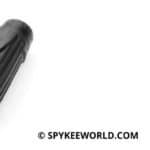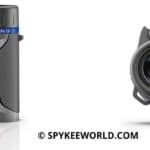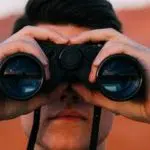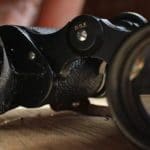Table of Contents
History of Binolculars: Early Beginnings
The oldest lenses can be traced to old and ancient Egyptian statues. The lenses were mainly used for decorative works. They were made of polished quartz crystals or glass. The lenses represented the eyes of the statues. This timeline dates back to the 4th and 5th dynasties of Egypt.
Reading Stones
Arab astronomer and mathematician Ibn al Haytham (956-1039) is said to be the first to describe optics. In his book ‘The book of optics’. he described the basics of geometric optics. Along with other concepts, he wrote about a hemispherical glass. According to his work, with the help of glass, he could make objects appear enlarged. But he only described these concepts and never mentioned their use in reading. There is no record that Ibn al Haytham ever used these glasses to read.
No one other than Vitello (1220-1280) paid attention to this in the history of binoculars. But things geared up when Vitello translated the book into Latin from Arabic. Monasteries at that time believed in the exchange of knowledge. This translated word spread quickly among the monasteries. The Franciscan order at that time particularly excelled in the spreading of knowledge.
Monk Roger Bacon of the Franciscan order applied some findings on optics. He believed that the spherical glass segments could be an excellent means for the visually impaired. His main aim was to have a tool for the older monks. It was to allow them to read the scriptures again. The invention of spectacles was a big milestone in popularising the lenses. The invention of spectacles is credited to two people in Tuscany, Italy in the 14th century.
Salvano d’Aramento degli Amati and Allessandro della Spina both independently developed spectacles. But both of them kept the process a secret. With many people working on glasses, the use of spectacles was common in the 15-16th century. People also realized the benefits of spectacles. They could see better and live a better life. Some people give the credit of inventing the spectacles to Roger Bacon as well. The early spectacle was two magnifying glasses that were riveted together. The spectacle would grip the nose. These were called as Rivet spectacles.
The Journey Ahead From Eyeglass
Role of Hans Lippershey
Around 1590, Hans Lippershey along with a Dutch pair of father and son, Zaccharias Janssen and Hans Jenssen worked on glasses. The trio experimented with various lenses and their combinations. They discovered that they could produce enlarged images of small objects. This is said to be the invention of the compound microscope. Another important point they learned was that with multiple lenses, the image was different. Hans Lippershey tried to get a patent for his device. The news of his work spread to other scholars of Europe in no time.
During this period people explored the benefits of mounting the side of the telescope by side.
Improvements In The Initial Stages
Galileo Galilei, the famous Italian physicist, astronomer, and engineer. He carried forward Lippershey’s idea and himself constructed such an instrument in 1609. This instrument is known as the Galilean telescope. He built it based on Galilean optics.
The Galilean telescope consists of one convex and one concave lens. It has a simple construction. The convex lens acts as the objective. While the concave lens acts as the eyepiece lens. Galileo positioned the lenses on both sides of the tube. He did this to match the focal point of the eyepiece with the focal point of the objective lens.
An advantage of the Galilean telescope was that it would produce an erect image. But it had a narrow field of view. It also didn’t have high magnification. Galileo’s construction is still used in binoculars of low magnification and jeweler’s loupes. This is because they are short and produce an erect image. The exit pupils were large which made the centerless critical. For use, they were either mounted on eyeglass frames or were custom-fit.
Sometime after Galileo, in 1611, the great astronomer Johann Keppler worked on telescopes too. He developed a new construction method. This is today known as Keplerian telescope. Keppler used a convex lens as the eyepiece. And concave lens as the objective. This is a characteristic difference from Galileo’s version. The distance between both the lenses was another new experiment.
He placed them at a distance which was the sum of focal of both the lenses. The Kepler’s telescope also had a much wider field of view than Galileo’s version. It also had better magnification. Kepler’s telescope produced an inverted image for the observer. On moving the tube of the telescope, the image moved to the other side. This problem can be countered with the use of prisms or additional lenses.
The box-shaped terrestrial binoculars were produced in the 17th century. The three main people were Cherubin d’Orleans, Pierto Patroni, and I.M Dobler. The designs were not popular due to poor quality and problems in handling.
J P Lemiere is credited for the first real binocular telescope. He devised it in 1825.
Sir Isaac Newton, in 1704, developed a new concept in the design of telescopes. He used a curved mirror to gather in and reflect the light to a point instead of a glass lens. The reflecting mirror acted as a bucket that collected light. Bigger was the bucket, more was the light it could collect. This development crushed the limits of magnification. With time, the principle remained the same but slowly the mirror grew in size to 6 meters in Russia in 1974.
The First Erect Image
Ignazio Porro was an Italian engineer who is to credit with the invention of Porro prism. It is the Porro prism that finds use in monoculars, binoculars, and stereomicroscopes as well. Patented in 1854, the Porro prism made it possible to get an erect image. It reversed the inverted images from the Keppler’s telescope. This enabled the observer to get a real image. For this purpose, he used two prisms which were half-cut cubes.
Both prisms placed at an angle of 90 degrees to each other. Further, Ignazio constructed a monocular and used it with the prisms to get an upright image. The use of Porro prisms decreased the total length of the instrument. These binoculars are generally wide and have a better distance between the lenses. Another change was that the length of binocular was lesser than the focal length of the objective lens. Being smaller, it was possible to use these binoculars in small spaces.
Carl Zeiss
Carl Zeiss is the most important name in the history of binoculars. The founder of the Carl Zeiss workshop in 1846, Carl Zeiss, was a German optician, scientist, and businessman. The empire that he set up stands tall today. Carl Zeiss AG operates even today as leaders in optical instruments. This is the one Carl Zeiss binocular we have reviewed.
He gathered the best engineers, opticians, and glassmakers of that time to have a top-class research team. The team redesigned many aspects of the manufacturing of optical instruments. Zeiss and Ernst Abbs collaborated and very soon revolutionized the field of optics. They developed new concepts in optical theory and design of optical instruments. Mainly in binoculars and microscopes. German chemist Friedrich Otto Schott who invented the borosilicate glass also worked with Carl Zeiss. In 1884, Friedrich, Ernst, and Carl Zeiss founded the Glass Technical Lab in Jena. The trio worked continuously and brought lots of improvements to the optical industry. The improved the optical properties and developed new glasses.
The Carl Zeiss company applied for a patent for a type of Porro prism binoculars on July 9, 1893. Many credit the Carl Zeiss company for the invention of binoculars. The patent led to the development of modern handheld binoculars. The modern binoculars still have a lot common with the patent application from 1893.
After Porro prisms, it was Achille Victor who introduced the roof prisms in the 1870s. The roof prisms binoculars either use the Abbe Koenig or the Schmidt-Pechan prism. The images formed are erect. The design is more compact and narrower than the Porro prisms. Another major difference is brightness. Roof prisms produce a rather dull image compared to porro prisms. The light transmission in roof prisms is reduced by about 12-15%.
The Best Binoculars On Amazon
1. Occer 12×12 Compact binoculars
- 【HIGH-POWERED LARGE EYEPIECE BINOCULARS】 This binoculars for adults has 12x magnification, 25mm objective lens and wide field of view, 273ft/1000yds, letting you look farther and see wider. Coating with FMC Broadband coating and premium BAK4 prism, it ensure imaging verisimilar.
- 【ADJUSTABLE EYE CUPS FIT EYEGLASS WEARERS OR NOT】The binocs can be pull down the rubber eyepieces and more fit the glasses wearer, getting close to lens and see easily. The long eye relief combined with large eyepiece give you a comfortable viewing while wearing sunglasses or eye glasses. For those who do not wear glasses, will gain more focused slight and feel more easeful through rising eye cups. The compact binoculars has 15mm large eyepieces, can see more clear image than other travel binoculars.
- 【FMC BROADBAND COATING TECHNOLOGY】The lightweight cruise binoculars is cover with BAK4 prism texture. The objective lens use optical FMC multilayer broadband green film, and the eyepiece-optical is made of blue FMC coating. All design ensure to provide a good image and make you have a amazing experience.
This Occer product is amongst the highest rated binoculars in the market. It has a high-powered and large eyepiece. The magnification is 12x, the objective lens is 25mm. It has a wide-field view of 367ft/1000 yards which lets you see view the surroundings better. It has an FMC broadband coating and BAJ4 prism for proper imaging. It is compact, portable, and perfect for bird watching, camping, traveling etcetera.
2. SkyGenius 10×50 Binoculars
- [Professional Powerful Binoculars] SkyGenius 10x50 Binoculars Designed with 10X power magnification, 50mm large objective lens, and 367ft/1000yds large field of view are ideal for fast-moving subjects such as bird watching, driving, sports events.
- [Weak Light Vision with Quality Optics] Design of Aspherical lenses and multi-layer coating guarantee excellent light transmission and well improve image brightness, contrast, and quality. birding binoculars can be used at night, but not in complete darkness
- [Durable, Solid, and Anti-slip Grip] Binoculars adopted durable structure with odorless rubber armor for shock-resistance and Anti-slip grip, making them not only in decent appearance of more wear-resistant but also perfect for outdoor activities such as climbing, hiking
These SkyGenius binoculars have a 50mm objective lens and 10x magnification. With a large viewing field of 367 ft/1000 yards, it is best for driving, hunting, bird watching. The multi-layer coating enables excellent light transmission for improved image quality. The images are bright with perfect contrast. The product is solid, durable, and has an excellent anti-slip grip. You can adjust the eyecups for a relaxed eye position.
3. Adorrgon 12×42 Binoculars
- 【Powerful 12x42 Binoculars, but Lightweight Enough, only 1.1 pounds】 Adorrgon 12x42mm binoculars deliver 367ft/1000yds large field of view. Capable of delivering a clear image from more than 650 feet away. Perfect for bird watching, hunting and sports events. 0.6 Pounds lighter than 10x50 full size binoculars.
- 【Clear Low Light Vision】Advanced Fully Multi-coated Binoculars with large 16.5mm BAK4 prism lens could deliver brighter vision in weak light conditions . Perfect for Hunting or Concerts at night.
- 【18.5mm Large Eyepieces & HD Vision , Larger Image, Brighter View】 2.25 times the image size of 14mm eyepiece (e.g. 10x25, 10x21 binoculars), 1.28 times of 16mm eyepiece (e.g. Ordinary 12x25,10x42, binoculars). Large eyepiece binoculars make full use of 12x magnification, deliver larger and brighter image to ensure clearer details.
Weighing only 1.1 pounds, this binocular has 12x magnification and a 42mm large objective lens. It has a large field of view of 367 ft/ 1000 yards. It can deliver a clear face from even 650 feet away. The large 16.5mm BAK4 prism with a fully multi-coated lens provides a sharp and clear image. With HD vision, it can also deliver a clear vision in low light conditions. It is ideal for traveling, bird watching, concerts, and sports, etc.
Final Thought
We hope you liked the history of binoculars. We have tried explain it in brief so that you can get the idea. This is more than enough if you want to learn about them or use them. If you have one, you should definitely check out, the best way to clean your binoculars.





Leave a Reply